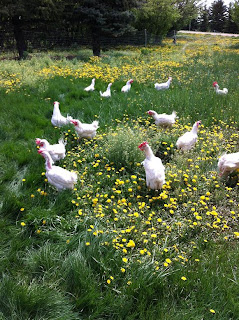I haven't posted an update about our pasture poultry yet!
In part 1, I will talk about our laying hens.
Interested in adding some laying hens to our operation, I started doing some research and decided to order a red sussex cross type layer this Spring. These birds won't be ready to lay eggs until September, so in the meantime, Larry saw an ad for retired battery hens.
These poor gals weren't old, like a year and a bit. They were used to being jammed in a cage most of their life, 4 or 5 of them in a tiny little cage with wire sides, bottoms and tops. Artificial light regulates their daytime so maximize production. They never see daylight or feel grass under their feet, or have enough room to stretch their wings.
We brought them home in April and set them in a temporary old wooden bin so they could acclimatize before turning them out on grass. Their nails were long, their combs pale. They LOVED the bit of sunlight that came in through the wire mesh doors, and the shavings we put down for them to scratch in, and that there was room to run around and stretch their wings! Quite a few died the first week, they didn't know what to make of their freedom and piled into corners at night.
Enjoying some sunlight:
What they looked like straight from the cages - and believe me, those are 2 of the better looking ones...!
An egg comparison with my own layers, and the Leghorns before they started eating grass:
Pastured egg on left, 'cage' egg on right:
Chicken manure is exellent fertilizer - this was taken in early Spring:
Can you tell the strip where the portable coop was? The green strip in the middle of the photo
Finally it warmed up enough that we could put the hens outside. This was their first day out:
I am happy to report that they adjusted well, enjoy eating grass and chasing bugs and taking dust baths. Their combs look redder, their toenails have worn down from running around, their legs are darker color, and so are their eggs!
Remember, everytime you buy something, you vote - with your money. You are saying, I endorse this product by paying for it. Don't pay for battery hen eggs. Buy free run or better yet, pastured eggs from a farmer that you know and trust.









